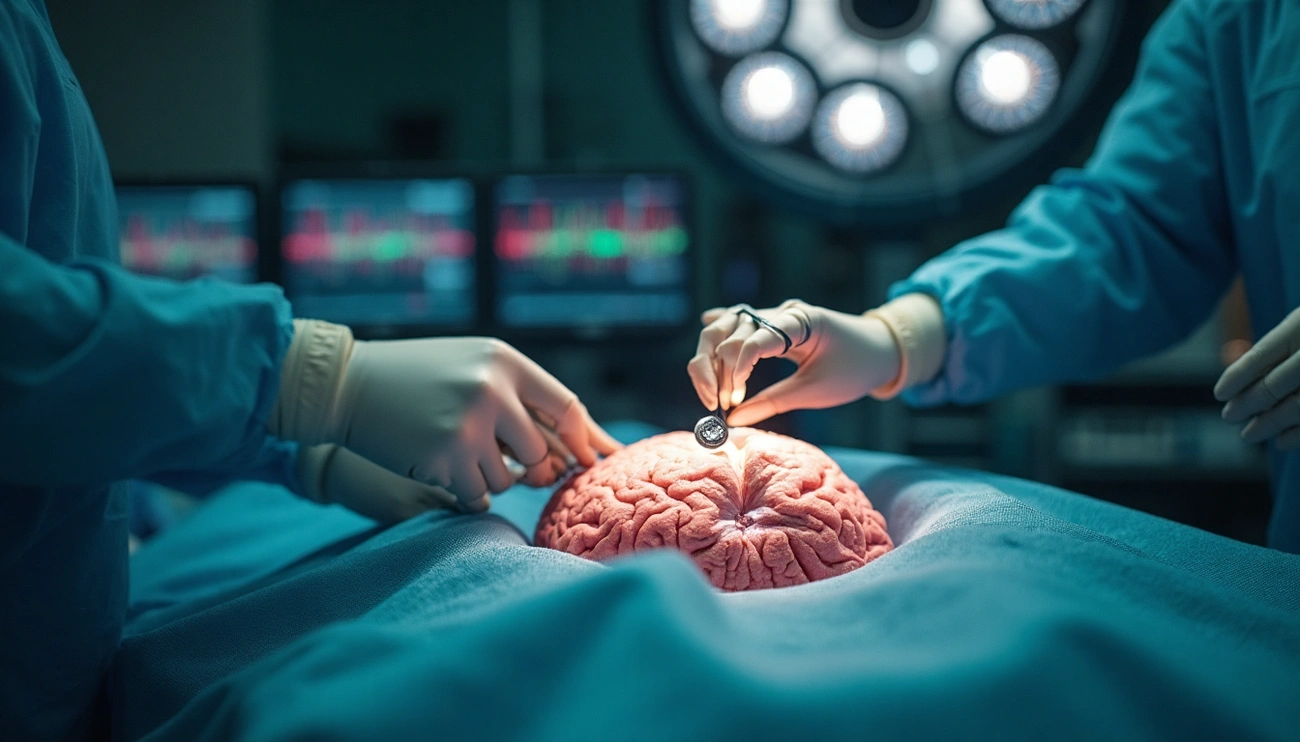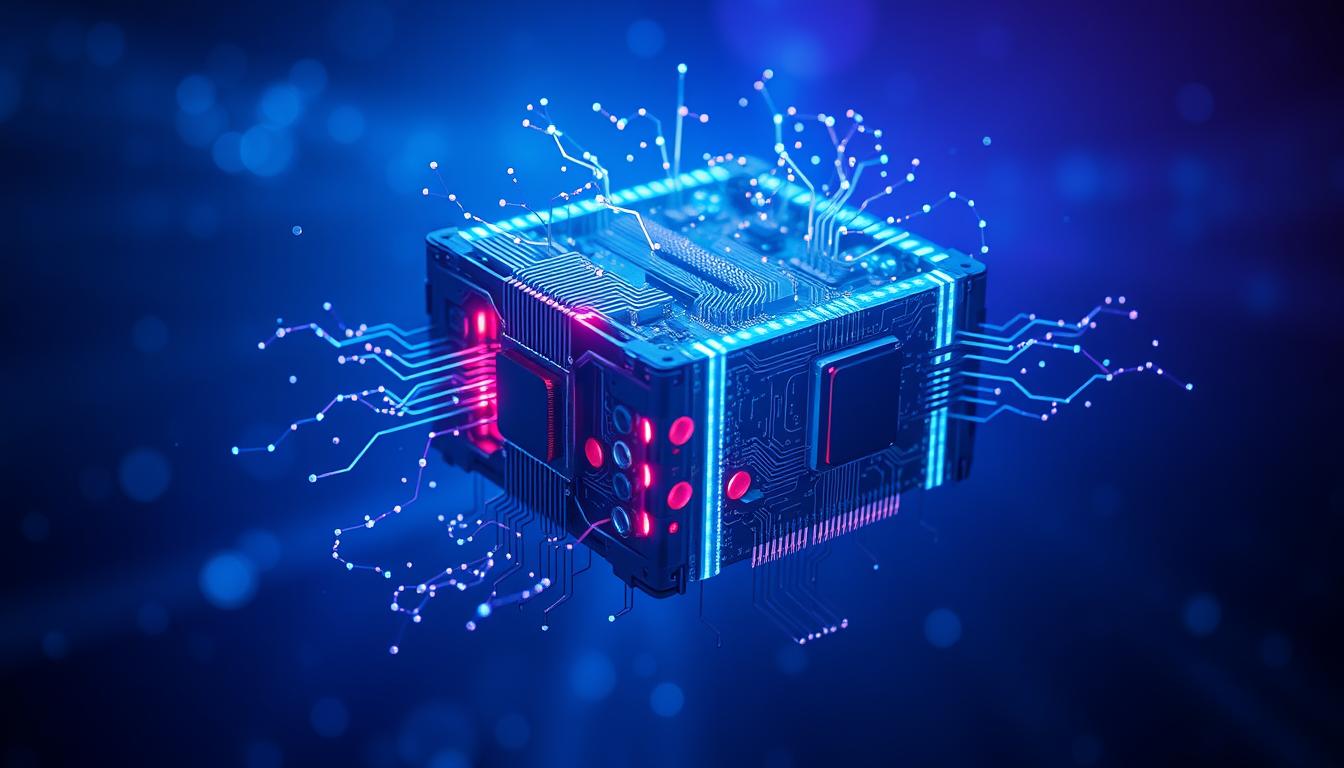No products in the cart.

Neuralink & Brain Chips: The Future of Human-Machine Interface Explained
The Neuralink brain chip has made the leap from science fiction to reality with its first successful human implantation in January 2024 . This revolutionary technology, created by Elon Musk’s company founded in 2016 , represents a significant milestone in brain-computer interfaces (BCIs) that record and decode brain activity .
Since that initial breakthrough, Neuralink has continued to advance rapidly. Indeed, over the past year, three people with paralysis have received these implants , including a second human participant in August 2024 . The technology works through flexible threads equipped with 1,024 electrodes that capture neural activity , with Neuralink’s full system containing an impressive 3,072 electrodes for high-density recordings . Additionally, the coin-sized device transmits these signals via Bluetooth to digital devices , opening new possibilities for human-machine interaction.
In this article, we’ll explore how the Neuralink brain chip functions, examine its real-world applications like Telepathy for quadriplegics and Blindsight for vision restoration , and discuss what this technology means for the future of human-machine interfaces.
What is Neuralink and How Does It Work?
Neuralink represents a pioneering advance in brain-computer interface (BCI) technology, designed to create a direct communication pathway between the human brain and external devices. Founded by Elon Musk in 2016 [1], this neurotechnology company has developed a fully implantable device that aims to restore movement, enhance communication, and expand human capabilities [2].
Neuralink chip structure: 1024-electrode threads
At the heart of Neuralink’s technology is the “Link” – a coin-sized implant placed beneath the skull that contains a battery and custom processor [3]. The device is hermetically sealed in a biocompatible enclosure designed to withstand physiological conditions several times harsher than those in the human body [4]. However, what truly distinguishes this technology are the ultra-thin, flexible threads extending from the implant.
These remarkable threads are merely one-tenth the thickness of a human hair [2], making them far less likely to damage brain tissue than traditional electrodes [3]. Each thread contains numerous electrodes capable of detecting electrical signals in the brain with extraordinary precision. The current system consists of 64 polymer threads, with each thread carrying 16 electrodes, creating a total of 1,024 electrodes [3][5].
The threads are primarily made of polyimide, a biocompatible material, with thin gold or platinum conductors [1]. Once implanted, they connect to specific regions of the brain responsible for functions such as movement, vision, or memory [3]. This arrangement allows the Neuralink chip to capture the firing patterns of individual neurons, which the onboard processor then decodes into intended movements or commands [3].
Wireless data transmission via Bluetooth LE
The Neuralink implant processes neural signals through advanced, custom, low-power chips and electronics [4]. After processing, these signals are transmitted wirelessly to the Neuralink Application, which decodes the data stream into actions and intents [4]. This wireless capability is one of Neuralink’s most significant innovations.
The system employs a proprietary low-energy Bluetooth-like protocol for communication [3], enabling real-time data transfer without requiring visible wires or bulky hardware. The device transmits brain activity data to smartphones or computers through a standard Bluetooth connection [1], effectively functioning like a “brain keyboard” that turns thought into data [3].
The implant is powered by a small battery that can be charged wirelessly from outside the body [4][5]. This inductive charging system works similarly to how you might wirelessly charge a smartphone, allowing for convenient use from anywhere without external power connections [3].
Neuralink surgical robot for thread implantation

Perhaps one of the most impressive aspects of Neuralink’s technology is its custom-built surgical robot designed to implant the threads with remarkable precision. The threads are so fine that they cannot be inserted by human hands alone [4], necessitating robotic assistance for accurate placement.
The surgical process begins with the removal of a small disk of skull and the protective dura layer [2]. Subsequently, the robot meticulously inserts the microscopic threads into the brain [3]. This precision robot features:
- A needle thinner than a human hair that grasps, inserts, and releases threads [4]
- Five camera systems and optical coherence tomography (OCT) for visualization [4]
- Vessel-avoidance capabilities to minimize tissue disruption [2]
- A design that allows it to insert up to six wires (192 electrodes) per minute [1]
The entire procedure is overseen by board-certified neurosurgeons [2], though Neuralink ultimately aims to automate the entire surgical process [5]. The robot can complete thread insertion in approximately 15 minutes [5], with the goal of making the procedure minimally invasive and allowing patients to leave the hospital on the same day [6].
Through this sophisticated technology, Neuralink has created a BCI system that makes direct brain-to-device communication possible, opening up remarkable possibilities for both medical applications and human-machine interaction.
Decoding Brain Signals: The Science Behind the Interface
The extraordinary capabilities of the Neuralink brain chip stem from sophisticated signal processing systems that transform raw neural activity into meaningful commands. Understanding this process requires examining the complex chain of operations that occur between brain activity and device action.
Neural signal acquisition and preprocessing
Before neural signals can be interpreted, they must first be captured and cleaned. The Neuralink system records both local field potentials (LFPs) – synchronized oscillations from small neuron clusters within the 300 Hz spectrum – and spike signals that represent individual neuron firings at frequencies exceeding 300 Hz [7]. These raw signals, nevertheless, contain substantial noise that must be removed.
Preprocessing involves several critical steps to enhance signal quality. First, downsampling reduces the sampling rate to decrease data volume while retaining essential information [3]. Subsequently, artifact removal tackles both physiological disturbances (head movements, blinking, muscle activity) and non-physiological interference (electrode contact issues, environmental noise) [3].
Various filtering techniques play crucial roles in preprocessing:
- Digital filtering selects specific frequency bands for targeted processing
- Independent Component Analysis (ICA) extracts signals by decomposing mixed signals into independent components
- Wavelet Transformation (WT) analyzes signals in both time and frequency domains simultaneously
- Canonical Correlation Analysis (CCA) mitigates electromyographic interference [3]
Furthermore, advanced techniques like multivariate empirical mode decomposition (MEMD) and deep learning methods address the non-linear characteristics of neural signals, improving the signal-to-noise ratio essential for accurate interpretation [3].
Spike detection and decoding algorithms
Spike detection represents the first crucial step in neural signal processing for brain-machine interfaces, fundamentally influencing all subsequent processing [8]. Traditional methods often required manual threshold setting, which proved impractical for long-term neural interfaces [8].
Modern spike detection algorithms balance detection accuracy with computational efficiency. The exponential component-power component (EC-PC) algorithm offers fully automatic unsupervised spike detection and produces higher decoding accuracy compared to other existing algorithms [8]. Correspondingly, hardware implementations evaluate three spike emphasizers: Non-linear Energy Operator (NEO), Amplitude Slope Operator (ASO) and Energy of Derivative (ED) [9].
Evaluations show that ED with average thresholding provides the most hardware-efficient choice for power consumption, whereas median-based approaches offer improved detection accuracy [9]. Additionally, cost-function analysis reveals that simpler absolute value operators with refractory period checks perform comparably to more complex nonlinear energy operators, making them suitable for real-time systems [8].
Once spikes are detected, decoding algorithms translate these patterns into intended actions. Neural decoding essentially interprets distributed brain activity that encodes environmental and body-state features [2]. These algorithms increasingly utilize machine learning approaches including support vector machines and deep learning methods that can adapt to neural plasticity and signal variations [4].
Bidirectional communication: stimulation and feedback
What truly distinguishes advanced neural interfaces like Neuralink is their bidirectional capability – not just recording from the brain but also delivering information back to it [5]. This creates a complete closed-loop system essential for natural control.
Bidirectional interfaces can provide artificial sensory feedback through electrical stimulation. For instance, temporally patterned intracortical microstimulation (ICMS) has successfully provided tactile feedback in brain-machine-brain interfaces [5]. In these systems, contact location information is conveyed through stimulation of specific receptive field regions in somatosensory cortex (S1), pressure information through stimulation amplitude, and timing through phasic stimulation [5].
One significant challenge in simultaneous recording and stimulation is the artifact problem – stimulation produces signals several orders of magnitude larger than the neural signals being recorded. To overcome this, researchers have implemented alternating 50 ms intervals dedicated solely to either neural decoding or stimulation delivery [5].
The science behind Neuralink’s interface ultimately aims to create what researchers describe as a “blueprint to convert the output of sensors on a prosthetic limb into patterns of stimulation that elicit somatosensory percepts” that can guide object manipulation [5] – essentially creating a seamless two-way connection between mind and machine.
Real-World Applications of Neuralink Brain Chip
Neuralink’s brain chip technology has moved beyond theoretical promise to demonstrate practical applications in multiple domains. Early clinical trials show how this technology is addressing specific medical conditions through direct neural interfaces.
Assistive control for quadriplegic patients
Neuralink’s primary clinical application focuses on restoring autonomy to people with spinal cord injuries. In January 2024, Noland Arbaugh, the first human recipient of the Neuralink implant, began using the device to control digital devices through thought alone [10]. Notably, during his first research session, Noland achieved a world record for human BCI cursor control at 4.6 bits-per-second (BPS), eventually reaching 8.0 BPS [1].
The impact on daily life has been substantial. Prior to receiving the implant, Noland relied on a mouth-held stylus that required caregiver assistance and caused discomfort with prolonged use [1]. In contrast, the implant has enabled him to:
- Control his laptop from various positions, including while lying in bed
- Play online computer games with friends (Chess, Civilization VI)
- Operate a Nintendo Switch console
- Use the device for up to 69 hours in a single week [1]
Given that approximately 180,000 Americans live with quadriplegia, with an additional 18,000 suffering paralyzing spinal cord injuries annually, this technology addresses a significant unmet need [1].
Blindsight: Visual cortex stimulation for vision restoration
Another pioneering application is Neuralink’s Blindsight project, which aims to restore vision through direct stimulation of the visual cortex. The approach involves implanting a microelectrode array into the visual cortex to stimulate neurons based on input from external cameras [11].
Research on visual cortical prosthesis (VCP) has shown that electrical stimulation can produce coherent visual percepts. In fact, both sighted and blind participants accurately recognized letter shapes through dynamic stimulation, with blind participants recognizing up to 86 forms per minute [12]. This technique traces shapes on the visual cortex surface by sequentially stimulating electrodes.
The primary brain region targeted, V1 (striate cortex), offers several advantages for visual restoration: it contains the highest density of neurons devoted to visual field representation, houses the smallest visual receptive fields in neocortex, and remains effective at evoking phosphenes even after decades of visual deprivation [13].
Speech synthesis from neural activity in ALS patients
For patients with amyotrophic lateral sclerosis (ALS) who face progressive speech impairment, Neuralink offers a promising communication solution. One ALS patient identified as “Brad” received an implant in November 2024, reporting the ability to write with his brain [10].
In related clinical trials, researchers have demonstrated online speech synthesis using implanted brain-computer interfaces in ALS patients. These systems translate neural activity directly into audible speech that resembles the user’s natural voice [14]. Remarkably, human listeners correctly identified 80% of synthesized words in listening tests [14][15].
The process employs a three-stage approach using recurrent neural networks to identify speech-related neural activity, transform it into acoustic representation, and recover the acoustic waveform [16]. At this point, the technology enables real-time conversation capability—transforming what would be text messaging into something more akin to a voice call [3].
Challenges in Brain Chip Technology and Human Trials
Despite Neuralink’s technical achievements, significant obstacles remain in brain chip technology development. These challenges highlight the complex reality behind the promising headlines.
Thread retraction and brain movement issues
Neuralink recently revealed that its first human implant experienced thread retraction weeks after insertion, causing reduced signal capture [7]. This issue wasn’t unexpected—the company knew from prior animal testing that threads might retract, removing sensitive electrodes that decode brain signals [17]. Although they implemented a software workaround by modifying their algorithm “to be more sensitive to neural population signals” [7], this adaptation raises questions about long-term stability.
The problem stems from natural brain movement within the skull, making thread movement difficult to solve [17]. As Robert Gaunt, a neural engineer, noted, “In the immediate days, weeks, months after an implant like this, it’s probably the most vulnerable time” [18]. Consequently, researchers face fundamental design challenges: anchoring threads risks brain tissue damage if they dislodge [18], yet leaving them unanchored permits retraction.
Foreign body response and signal degradation
When any foreign object enters the brain, it triggers a complex defensive reaction. This foreign body response (FBR) follows a predictable pattern:
- Blood-plasma proteins adsorb to the implant surface [8]
- Monocytes transform into macrophages at the implant site [8]
- Macrophages activate and form giant cells [8]
- Fibroblasts create fibrotic tissue encapsulation [8]
This biological reaction ultimately forms a dense cellular capsule around the implant, increasing electrode impedance and necessitating constant stimulation parameter adjustments [8]. Over time, this process causes signal attenuation and sharp impedance rises [9], potentially leading to device failure.
Clinical trial transparency and FDA compliance
Ethical concerns about Neuralink’s approach to human trials persist. The company received FDA approval for human testing in May 2023 [19] after initially being rejected in 2022 due to concerns about implantation, wire migration, and removal procedures [20]. Nevertheless, critics note that Neuralink did not register at ClinicalTrials.gov, violating customary scientific practice [19].
FDA inspections in 2023 identified deficiencies in record-keeping and quality controls at Neuralink’s animal research facility [21]. Moreover, experts argue this lack of transparency “violates fundamental ethical guidelines for biomedical research” [22]. Until these concerns are addressed, questions about long-term safety, device degradation, and patient care after trial completion will remain unanswered [22].
The Future of Human-Machine Interfaces
Looking toward the horizon, Neuralink’s technology aims to transcend therapeutic applications and venture into enhancing human cognition in unprecedented ways.
Neuralink’s roadmap: memory enhancement and AI symbiosis
Beyond restoring lost functions, Neuralink envisions a future where brain chips augment human capabilities. Recent research with AI-driven neural interfaces demonstrated remarkable cognitive improvements:
- Memory enhancement by 23%
- Problem-solving capacity increase of 24%
- Creativity improvement of 26% [23]
This suggests the possibility of what Musk describes as “symbiosis with artificial intelligence” [5]. Rather than competing with AI, humans could potentially integrate with it, accessing vast knowledge instantaneously. The ultimate goal is to create a “digital layer above the cortex” [5] that functions like a “saved game situation” where users can resume and upload their last brain state [5].
Neuralink network IO and real-time data compression
A significant technical hurdle for Neuralink involves data transmission. Currently, the implant generates approximately 200 times more brain data per second than it can wirelessly transmit [24]. Hence, Musk initiated a public challenge seeking algorithms that could achieve “greater than 200x compression” while maintaining lossless quality, operating in real-time, and consuming minimal power [5].
This represents a fundamental information theory problem constrained by physics rather than software engineering [24]. Neuralink released one hour of raw brain recordings from a monkey playing MindPong to kickstart the compression challenge [24], highlighting how crucial efficient data transfer is for wireless BCIs.
Integration with AR/VR and spatial computing platforms
The fusion of brain-computer interfaces with augmented and virtual reality creates powerful possibilities. BCIs with AR/VR provide additional communication channels that increase human-computer interaction bandwidth [25], either explicitly through active commands or implicitly by monitoring user states like attention and workload [25].
For rehabilitation, VR creates immersive training environments while BCIs enable real-time neural feedback. As demonstrated in the REINVENT platform for stroke patients, BCI technology allows individuals to drive virtual avatar arms through detected neural signals that indicate movement attempts [25]. Likewise, BCIs can monitor anxiety markers and modulate VR environments accordingly for treating phobias [2].
Overall, these integrated systems promise to create adaptive scenarios that respond directly to neural activity, optimizing therapeutic interventions and enhancing human-machine interaction [2].
Conclusion
Neuralink has undoubtedly transformed the landscape of brain-computer interfaces since its founding in 2016. The journey from concept to human implantation represents a significant milestone in medical technology. Through its sophisticated system of ultra-thin threads equipped with 1,024 electrodes, wireless data transmission capabilities, and precision surgical robots, this technology offers unprecedented neural recording and stimulation possibilities.
The real-world applications we’ve examined demonstrate Neuralink’s practical impact. First, quadriplegic patients like Noland Arbaugh have regained digital control through thought alone, achieving record-breaking cursor control speeds. Additionally, the Blindsight project shows promising results for vision restoration through visual cortex stimulation. Furthermore, ALS patients benefit from neural speech synthesis, opening new communication pathways for those who have lost their ability to speak.
Nevertheless, significant challenges remain unresolved. Thread retraction caused by natural brain movement threatens long-term stability. The foreign body response still poses risks of signal degradation over time. Lastly, questions about clinical trial transparency highlight the ethical considerations that must accompany technological advancement.
Despite these obstacles, the future of human-machine interfaces appears boundless. Neuralink’s roadmap extends beyond medical applications toward cognitive enhancement and AI symbiosis. Though data transmission limitations and compression needs require solutions, the potential integration with AR/VR platforms points toward increasingly seamless human-machine interactions.
We stand at the threshold of a new era where the boundaries between human cognition and digital systems grow increasingly blurred. The Neuralink brain chip exemplifies both the extraordinary potential and complex challenges of creating direct neural interfaces. This technology promises not just to restore lost functions but potentially to expand human capabilities in ways previously confined to science fiction. The coming years will certainly reveal whether these brain chips fulfill their promise of revolutionizing how humans interact with machines and perhaps with each other.
Key Takeaways
Neuralink’s brain chip technology has evolved from experimental concept to clinical reality, offering transformative possibilities for human-machine interaction and medical treatment.
• Neuralink’s 1,024-electrode system enables quadriplegic patients to control devices through thought alone, achieving record-breaking 8.0 bits-per-second cursor control speeds.
• The technology addresses critical medical needs including vision restoration through Blindsight, speech synthesis for ALS patients, and digital autonomy for paralyzed individuals.
• Technical challenges persist, including thread retraction from brain movement, foreign body response causing signal degradation, and data compression limitations requiring 200x improvement.
• Future applications extend beyond medical treatment toward cognitive enhancement, with early research showing 23-26% improvements in memory, problem-solving, and creativity.
• Integration with AR/VR platforms promises seamless human-machine interfaces, potentially creating adaptive environments that respond directly to neural activity and user states.
The convergence of neurotechnology, AI, and immersive computing is reshaping the boundaries between human cognition and digital systems, marking the beginning of a new era in human-machine symbiosis.
FAQs
Q1. What are the current capabilities of Neuralink’s brain chip? Neuralink’s brain chip allows quadriplegic patients to control digital devices through thought alone. The first human recipient achieved record-breaking cursor control speeds and can now play online games, operate gaming consoles, and use a computer without physical assistance.
Q2. How does Neuralink’s technology work? Neuralink’s system uses ultra-thin threads with 1,024 electrodes implanted in the brain to capture neural signals. These signals are processed and wirelessly transmitted to external devices via Bluetooth, allowing for direct brain-to-device communication.
Q3. What are the potential future applications of brain chip technology? Future applications may include memory enhancement, improved problem-solving abilities, and even a symbiosis with artificial intelligence. Research suggests potential cognitive improvements of 23-26% in various areas, and integration with AR/VR platforms could create adaptive environments responding to neural activity.
Q4. What challenges does Neuralink face in developing its brain chip technology? Neuralink faces several challenges, including thread retraction due to brain movement, signal degradation from the body’s foreign object response, and limitations in wireless data transmission. The company is also working to address concerns about clinical trial transparency and long-term safety.
Q5. How might brain chip technology impact human-machine interaction in the future? Brain chip technology could revolutionize human-machine interaction by enabling direct neural control of devices, enhancing cognitive abilities, and creating seamless interfaces with digital systems. This may lead to new forms of communication, learning, and interaction with technology that were previously only possible in science fiction.




